Caterpillars
Maggies Garden Forum:
Some Garden Creatures, Great and Small:
Caterpillars
By Maggie on Wednesday, March 12, 2003 - 11:53 pm: Edit PostIt is always so hard to ID caterpillars from the limited book resources I have on hand. Maybe others have that prob too - so let's work together and see if we can decipher some from our pics.
Everyone is welcome to post pics of their mystery'pillars too.
I photographed this one in early summer in a garden east of Ft. Worth.
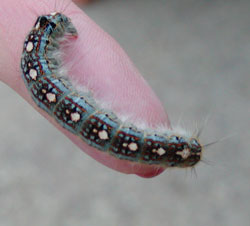
... and a came across another one like it in my garden a few days later. The pic isn't as clear as above, but I remember it being the same.
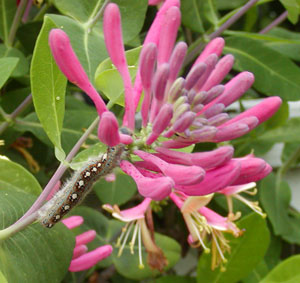
They resemble a pic of the Eastern Tent caterpillar in a book I have,.. as far as spots, colors and stripes go, except the tent critter has two sets of dots instead the one central row of them. Let's hope its a more desirable winged friend than the tent guys.
Anyone know what it is?
By Nicola on Sunday, March 16, 2003 - 6:45 am: Edit PostHi Maggie I have no idea which one it is but what wonderful markings and lovely colours. Can't you get a load together and train them to sit around your wrist as a bracelet. Go on, I'm sure you can manage it.
By Maggie on Sunday, March 16, 2003 - 9:57 pm: Edit PostI could make a caterbraclet for you outta this one Nicola, since this is now their season.
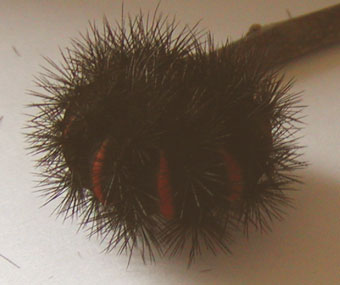
Heck, I even know what this one turns into - the Giant Leopard Moth.
This may be the official last week of winter, but it was 80* yesterday and today in Ft. Worth. Warm enough to wake the butterflies. There was a freshly opened Tiger Swallowtail floating around the garden. Wonderful.
By Maggie on Monday, March 17, 2003 - 9:58 pm: Edit PostHere's another prickly pretty.
Dunno what it is tho.
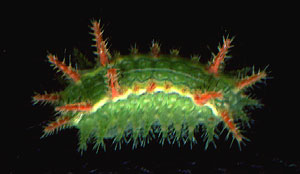
By Maggie on Sunday, March 23, 2003 - 1:17 am: Edit PostHow are you at caterpillar IDs Sandra?
Here's another angle on that Red Green show.
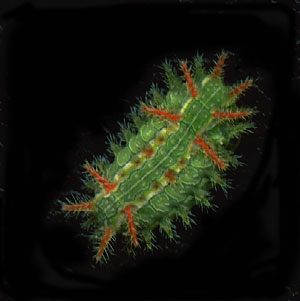
By Sandra C. on Monday, March 24, 2003 - 11:38 pm: Edit PostI was afraid you'd ask. No,your prickly pretty isn't in my limited resources, either. I have the National Audubon Field Guide to North American Butterflies, and after getting it, realized that it has very good pictures of only a very few caterpillars.
The little Peterson First Guide to Caterpillars has one that is a little similar in shape, called a Saddleback Caterpillar--maybe a relative, and it is a moth.
Where did you find it, and was there more than one? It is really pretty, but I don't think I'd want to touch it!
By Maggie on Tuesday, March 25, 2003 - 11:55 pm: Edit PostYes,,, I had marked that page in Petersons where the Saddleback is too, but it doesn't quite get it does it.
Larry found it in the garden last summer. I came across these pics of it while looking thru his files. He is very much an Entomology admirer.
In the summer we enjoy checking out the tinies that land in the pool through microscope - fascinating stuff!
By Nancy L. McHugh on Wednesday, July 27, 2005 - 6:28 am: Edit PostHope you can help. I live in Central Florida. It is now the end of July. I found a huge catepillar, approximately 6 inches long. He was a light color. Sort of a Aqua Blue. Had black horns on his head. I think there were 3 on each side of his head. Orange tips. two black short ones on his tail. He was as big around almost as my thumb. Beautiful creature. Does anyone have any idea what he is and what he turns into?
By Maggie on Wednesday, July 27, 2005 - 10:42 pm: Edit PostEverything about it, except the amount of horns you describe, sounds like the Sphinx Moth caterpillar. They have two antennae on the head and one horn on the tail. It is commonly called a tomato hornworm and tobacco hornworm. More specifically: Manduca quniquemaculata and M. sexta.
Besides tomato and tobacco, they are also fond of plants in the curcurbit family: cucumber, melon, pumpkin and squash. Also like peppers and eggplants and I have found them on my Daturas in the past.
If you have enough plants to share with them, it really is worth letting them feed and live on to morph into Sphinx moths. Beautiful huge things that act like hummingbirds and come out to feed/pollinate at dusk. Wonderful to watch them swoosh around the blooms.
By kellie on Tuesday, August 23, 2005 - 4:03 pm: Edit PostI have an enormous caterpiller in my pine tree. I noticed him because I saw droppings that I thought at first were from our local rabbits, but not. I looked up and there he was. About 3 inches long, almost an inch across, bright green, with four yellow "horns" in the front and I think on on the rear. Any idea what it is?
By Maggie on Tuesday, August 23, 2005 - 9:33 pm: Edit PostI'd be scared of a caterpiller with rabbit-sized poop!
Maybe it is the Imperial Moth piller. Here is a link with pic.
The text says it also comes in green.
By Maggie on Saturday, August 27, 2005 - 8:33 pm: Edit PostBe sure to let us know if you ever get to see which Imperial he might be. And wear camera in the garden from now on 
By Maggie on Monday, August 29, 2005 - 9:54 pm: Edit PostOkay, finally id'ed the caterpillar in the pics at top of this page. It is the Forest Tent Caterpillar, Malacosoma disstria, ranging across most of North America.
Although it is called a tent caterpillar, the larvae do not construct tents like other Malacosoma species. Instead, they spin silken mats on trunks and large branches to molt or rest. Larvae also make silk strands for traveling to and from feeding sites.
The fuzzy brown moth camouflages itself very well on bark. We found one of the adults on bark of our old pecan tree this summer - only spotted it because a red cardinal was trying to get at it, which made me go see what was all the fuss.





